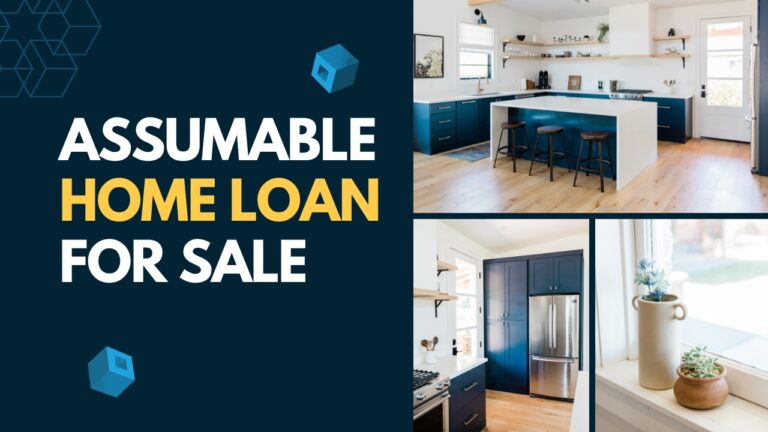Assumable loan homes for sale have quickly become a valuable tool in today’s real estate landscape, offering buyers attractive financing terms. By taking over an existing mortgage from their seller and taking on their monthly payments as their own, assuming loan homes make homeownership more attainable than ever.
What Is an Assumable Loan Home?
An assumable mortgage loan allows sellers to pass down an existing loan directly to buyers without needing new financing for themselves, streamlining transactions and potentially saving time and money in the process. This option makes this form of financing much simpler – saving the buyer both time and money when purchasing property!
Key Characteristics of Assumable Loan Homes for Sale:
- Existing Mortgage Terms: Home buyers inheriting existing loan terms like the interest rate, repayment period and remaining principal balance from their seller are inheriting them as part of an assumable loan homes for Sale mortgage agreement.
- Loan Approval Required: Before taking out a mortgage loan, prospective buyers must go through an intensive financial assessment by their original lender to make sure they satisfy their creditworthiness requirements.
- Down Payment: Although not mandatory, down payments may be requested or required by lenders or sellers.
Benefits of Assumable Loan Homes For Sale
Its Assumable loan homes for Sale This can offer numerous advantages for potential buyers:
- Lower Interest Rates: When taking over an existing mortgage, buyers may experience lower interest rates compared to market rates.
- Reduced Closing Costs: Eliminating new financing could drastically decrease closing costs associated with their purchase.
- Process Simplified: Assuming a mortgage streamlines the transaction, cutting paperwork and speeding up the closing process.
Who Can Benefit From Assumable Loan Homes?
Assumable loan homes For Sale can be especially appealing for:
- First-time homebuyers: Assumable loans can make homeownership more attainable for those with limited financial resources. Buyers looking for lower monthly payments: Assumable Loan Homes For Sale provide more budgeting flexibility as monthly mortgage payments decrease with an assumable mortgage loan.
- Buyers in high-interest-rate environments: Assumable loans provide access to lower interest rates even if current market rates are unfavorable.
How to Identify Assumable Loan Homes
Locating homes eligible for assumable loan financing requires taking an intentional, targeted approach:
- Real Estate Listings: Search for listings specifically mentioning “assumable loan homes for sale” or “assumable mortgage.” Real Estate Agents: Consult with experienced real estate agents who specialize in assumable loan transactions for guidance.
- Online Resources: Buyers should utilize online platforms dedicated to connecting them with assumable loan properties. What to Consider When Assessing Assumable Loan Opportunities
When assessing potential assumable loan properties, buyers must carefully evaluate:
- Overall Property Value: To ensure the value of the home aligns with its remaining principal balance on an assumable mortgage.
- Mortgage Terms: Carefully consider existing mortgage terms including the interest rate, repayment period and any prepayment penalties applicable.
- Financial Qualification: Evaluate your finances to make sure they meet the lender’s creditworthiness standards for taking out a mortgage loan. Additional Considerations
- Seller Motivation: Understand why a seller is offering an assumable mortgage as this may impact their willingness to negotiate.
- Home Inspection: Conduct a thorough home inspection so as to identify any potential issues with the property and any that might require repair or maintenance.
- Legal Guidance: Seek legal guidance from an attorney experienced in real estate transactions to protect your interests during this process.
Understanding Assumable Loans While assumable loans have enjoyed renewed attention in recent years, their history dates back to the 1970s and early 1980s due to high interest rates prompting lenders to offer assumable mortgages as an attraction tool and aid sales of homes. When interest rates started decreasing again after this period however, so too did their popularity decrease significantly.

Assumable loans have seen an upswing, driven by several factors:
Rising Interest Rates: With rates on the rise, buyers are turning to assumable loans in search of lower rates and reduced borrowing costs.
Tighter Lending Standards: Stricter lending criteria have made it more challenging for some borrowers to secure traditional financing, making assumable loan homes for sale a more attractive alternative option.
Rising Awareness: With increased access to information regarding assumable loans, both buyers and sellers are beginning to see their potential benefits.
Types of Assumable Loans
Not all mortgages can be assumed; their asumability depends on its terms and conditions as well as lender policies. Here are common examples of assumable loans:
- VA Loans: Loans guaranteed by the U.S. Department of Veterans Affairs can often be assumed, allowing eligible veterans to transfer their mortgages onto qualified buyers.
- FHA Loans: Loans insured by the Federal Housing Administration may be assumable in certain situations, facilitating access to affordable housing.
- USDA Loans: USDA loan guarantees may also be assumable, providing opportunities for homeownership in rural areas.
- Conventional Loans: Conventional loans may include assumability clauses; however, this practice is less prevalent than among government-backed loans.
Steps for Assuming a Loan:
The typical process for taking over an existing mortgage involves these steps:
- Prequalification: Buyers interested in assumable loans should first get prequalified with their original lender to assess eligibility and potential loan terms. Offer and Acceptance: Once an assumable property is found, offers must include taking over its mortgage payments as part of its offer package.
- Review from Lender: To assess whether they can accept the loan, lenders review a buyer’s financial qualifications and creditworthiness to ascertain whether or not they qualify to assume it.
- Appraisal and Inspection: Your lender may require an updated appraisal to make sure the property’s value aligns with the loan amount, while home inspection can help identify any potential problems that could arise with it.
- Assumption Agreement: Once approved, lenders develop an assumption agreement which details all terms associated with loan transfers including payments schedules, interest rates and any additional fees associated with it.
- Closing: At closing, both buyer and seller sign an assumption agreement and other documents to complete the transfer of ownership and mortgage assumption.

Buyers should perform thorough due diligence on both the property and existing mortgage terms before purchasing, taking note of any prepayment penalties or transfer fees related to taking over an existing loan.
Contingency Clause: For optimal results, it’s wise to include a contingency clause in any offer, allowing for financing review and potential withdrawal if loan terms or property condition prove unacceptable.
Professional Advice: Seek professional assistance from real estate agents, mortgage brokers and attorneys when undertaking assumable loan transactions. They will guide you through their complicated processes with ease.
Conclusion
Assumable loan homes present prospective buyers with an excellent opportunity to achieve homeownership goals at more attractive financial terms and achieve homeownership quickly. By thoroughly exploring all available options and understanding the process, buyers can confidently navigate the real estate market – possibly finding their dream home with manageable monthly payments.

